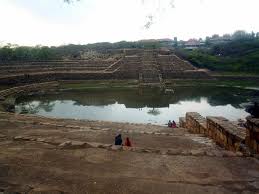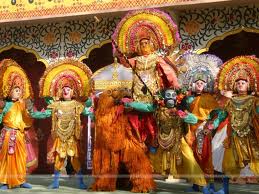Surajkund
Book Now
Surajkund Near Delhi
 Surajkund is an ancient reservoir of the 10th century, 2 kilometres away to the south west from a more ancient dam of the 8th century called the Anagpur Dam; both are located in Haryana, India. Surajkund meaning is ' Lake of the Sun ' . It is an artificial Kund built in the backdrop of the Aravalli hills with an amphitheatre shaped embankment constructed in semicircular form. It is said to have been built by the Tomar king Suraj Pal of Tomar dynasty in the 10th century. Tomar was a sun worshipper and he had therefore built a Sun temple on its western bank. Surajkund is an ancient reservoir of the 10th century, 2 kilometres away to the south west from a more ancient dam of the 8th century called the Anagpur Dam; both are located in Haryana, India. Surajkund meaning is ' Lake of the Sun ' . It is an artificial Kund built in the backdrop of the Aravalli hills with an amphitheatre shaped embankment constructed in semicircular form. It is said to have been built by the Tomar king Suraj Pal of Tomar dynasty in the 10th century. Tomar was a sun worshipper and he had therefore built a Sun temple on its western bank.
Another 'kund' by the same name as ‘Suraj Kund’ existed in Sunam city, a tahsil and sub division of the Sangrur District in Punjab. This was sacked by Mahmood Ghaznvi or Taimur Lane. The temple is now in ruins.
History of Surajkund
According to bardic tradition the Tomar kings who initially lived near the Aravalli hills shifted to the Surajkund area near Lal Kot, which was built by the Tomars. Lal Kot was renamed as Qila Rai Pithora, after Prithvi Raj Chauhan. Archeological excavations have revealed existence of a Sun temple here based on ruins that can be seen even now. Certain carved stones were recently recovered from the reservoir. Some stones have also been re–used in subsequent restoration works. Some historians also claim that it was named after King Surajpal himself who built it. It is also said that Suraj Pla built this lake for his daughter.
During the Tughlaq Dynasty rule of Feroz Shah Tughlaq (1351–88), the reservoir was refurbished by rebuilding the steps and terraces with stones in lime mortar. On the western bank of the reservoir, a garhi was built close to the ancient site of the Sun temple. Though historians have not specifically alluded to this tank, it is also said that it was built in 686 AD by Suraj Pal son of Anang Pal I. It is in the form of a segment (semi circular) with the chord on its west side. Another theory for the name 'Suraj' suffixed to the kund (lake) is that it was named after the Sun Temple that existed on the east side of the lake.
Even though the Tomar dynasty vanished in the 12th century, the Surajkund has not been affected. It attracted the attention of the Haryana Government to develop the area as a tourist spot by introducing an annual crafts 'Mela' or "fair" titled "Surajkund Crafts Mela" in the precincts of the lake, which over the years has attracted wide publicity and become an iconic event.
Architecture of Surajkund
The reservoir has been built in the shape of the rising sun with an eastward arc. It is enclosed within a steep embankment made in semi-circular shape made of stepped stones. Rain fall was intercepted here to create a reservoir of 130 m (427 ft) diameter to meet the water shortage in Delhi. It has an area of 40 ha (99 acres). The reservoir provides a grand spectacle, and in the past it was the hunting forest resort. It abounds in dancing peacocks. The reservoir is filled up during every monsoon season but remains dry during summer, before the onset of the monsoon rains. The tank underwent major repairs in the 1920s during the British times.
Surajkund Mela
 In the backdrop of the lake, during the spring season, every year from February 1–15, a colorful traditional craft festival of India is held in the precincts of Surajkund. This fair was first started in 1987. Traditional craftsman from all parts of the country participate in this annual celebration named as the “Surajkund Crafts Mela” or "Surajkund designer’s Village”. Designer items created by 50 best designers and craftsmen in wood, metal, bamboo, iron, glass, textiles and stone can be seen here. This Mela is visited by lovers of arts and crafts from all over the world. The fair is held with a different theme every year on Indian culture and crafts. The theme, specific to a state of India, is depicted at the entrance to the Mela grounds and provides an ambience of that particular state with characteristic colors, materials, architecture, furniture and decorations. In the backdrop of the lake, during the spring season, every year from February 1–15, a colorful traditional craft festival of India is held in the precincts of Surajkund. This fair was first started in 1987. Traditional craftsman from all parts of the country participate in this annual celebration named as the “Surajkund Crafts Mela” or "Surajkund designer’s Village”. Designer items created by 50 best designers and craftsmen in wood, metal, bamboo, iron, glass, textiles and stone can be seen here. This Mela is visited by lovers of arts and crafts from all over the world. The fair is held with a different theme every year on Indian culture and crafts. The theme, specific to a state of India, is depicted at the entrance to the Mela grounds and provides an ambience of that particular state with characteristic colors, materials, architecture, furniture and decorations.
Other Attaractions
A natural spring called the Siddha–Kund, held in reverence, is seen about 600 m (1,969 ft) to the south of Surajkund, which is frequented by pilgrims.
Asola Bhatti Wild Life Sanctuary
Asola Bhatti Wild Life Sanctuary is on the Southern Ridge of the northern terminal of Aravalli Hills, close to the Surajkund. It acts as the green lung & carbon sink for Delhi. A trail of 2 km (1 mi) exhibits floral & faunal diversity along the topography of the area of Aravalli Mountain Range which is now a protected area.
Suraj Kund in Sunam
A large Sun Temple called the Suraj Kund, located to the east of the Sunam city, about 1.5 kilometres away in the tahsil and sub division of the Sangrur District, was destroyed by Timur or Mohammad Ghaznavi. It is also said that Saraswati River was flowing nearby. The Suraj Kund is now in a dilapidated condition. It is situated on the Ludhiana-Hisar railway line, and is connected by road with Patiala, Sangrur, Bathinda, Ludhiana, and Chandigarh.
Ecological issues
The ecological disaster that is causing the rapid depletion of ground water in the Aravalli hill range between Tughlaqabad and Gurgaon via Surajkund due to indiscriminate mining has invited the attention of the Supreme Court of India through the efforts of environmental activist. This activity is also stated to be affecting the adjoining Asola Forest and Wildlife Sanctuary.
|